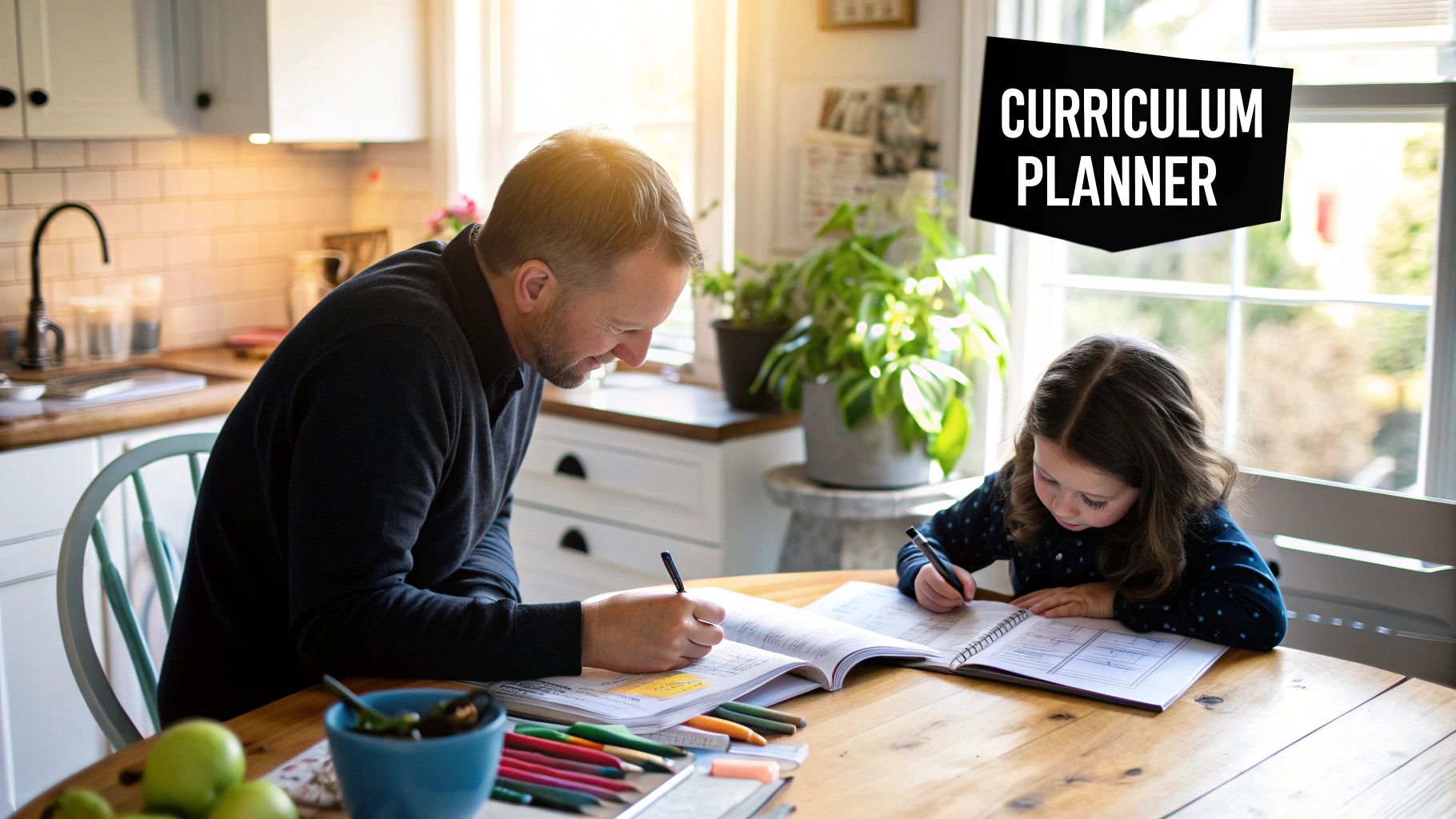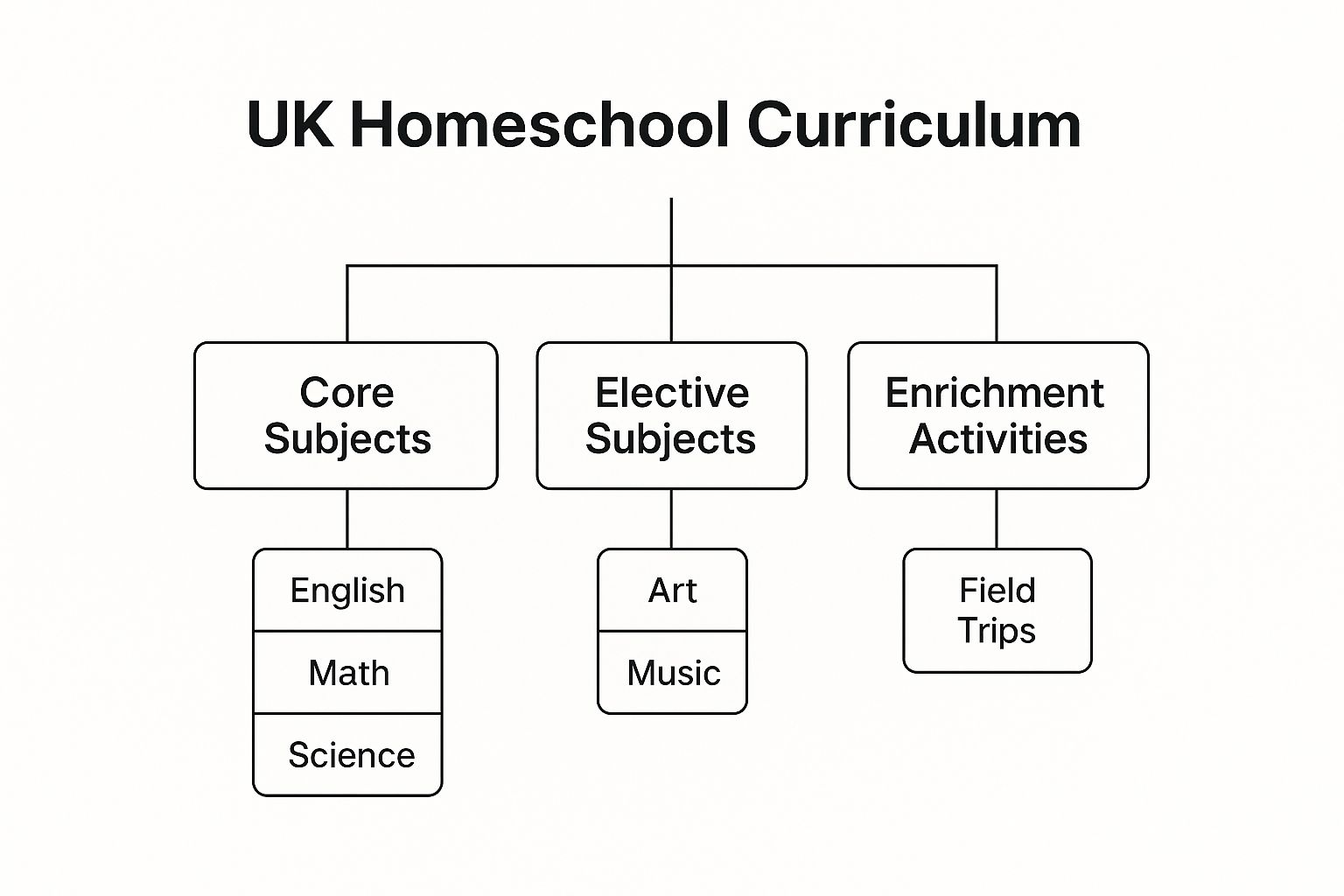Choosing a UK homeschool curriculum is the first step on a genuinely personal and rewarding path for your family. It’s a chance to move away from a one-size-fits-all model and build an education that truly fits your child’s unique personality and curiosity. This guide is here to give you the confidence you need as you take these first exciting steps.
Starting Your Homeschool Journey with Confidence
Deciding to home educate is a huge decision, one that often brings a mix of excitement about the possibilities and a totally normal dose of nerves. You're not just changing how your child learns; you're redesigning their entire educational world. This is your opportunity to put their needs, interests, and wellbeing right at the heart of their learning.
It's a path more and more families are choosing. Recent figures show that around 111,700 children in the UK were in elective home education as of autumn 2024. That’s a massive jump from previous years, highlighting a growing desire among parents for alternatives that better support their children's learning styles and mental health.
Understanding Your Role and Freedom
The move from being just a parent to a parent-educator can feel pretty big. You might worry about ‘getting it right’ or whether you’re really equipped for the job. But here’s the thing: you've been your child's first and most important teacher since day one. Homeschooling is just an extension of that natural role, grounded in a deep understanding of who your child is.
The legal framework in the UK actually gives you a surprising amount of freedom. The law simply states that you must provide a ‘suitable education’ based on your child's age, ability, and aptitude. It doesn't force you to follow the National Curriculum to the letter.
This freedom is the cornerstone of home education. It empowers you to move beyond rigid timetables and standardised tests, creating a learning environment that breathes with your family’s rhythm and values.
This means you can design an education that truly fits. Imagine your child, who struggles to sit still, learning about fractions not from a worksheet, but by excitedly measuring out ingredients for a cake in the kitchen. If they suddenly become fascinated by ancient Egypt, you can spend weeks diving deep into it—weaving in history, geography, art, and even a bit of maths by calculating the angles of pyramids. You have the flexibility to run with their passions.
Building Your Confidence as an Educator
Confidence comes from knowing your options and having support. As you start out, it’s really helpful to get your head around the different educational philosophies and teaching approaches out there. This isn’t about needing a degree in education; it’s about finding a style that feels right for you and your child. To feel more prepared, it's worth familiarising yourself with the different types of teaching styles.
Getting a handle on the practical side of things is also key to feeling prepared. Knowing how to officially start the process and what your local authority needs from you can make the administrative side feel much less intimidating. For a clear, step-by-step overview, our guide on how to homeschool in the UK is the perfect place to start. It walks you through the essentials, helping you begin with clarity and peace of mind.
Finding Your 'Why' for Home Education

Every family’s decision to home educate is a story, and it always begins with a powerful ‘why’. This reason is the anchor that will ground you, the motivation that will fuel you, and the vision that will guide your choice of a uk homeschool curriculum.
Figuring out your personal ‘why’ isn't just a box-ticking exercise; it’s the heart of your entire journey.
For many, the push comes from a place of deep concern for their child's wellbeing. Perhaps your bright, curious child has started to shrink in a busy classroom, their confidence chipped away by social pressures or bullying. You see their light dimming, and you know, instinctively, that they need a safer, more nurturing space to flourish.
This desire to protect and restore their happiness is a profoundly valid reason to bring their education home.
Listening to Your Child's Needs
Sometimes, the school system itself, despite its best intentions, simply isn’t the right fit. A child with Special Educational Needs and Disabilities (SEND) might need a more flexible pace or one-to-one attention that a class of thirty just can’t offer. Or perhaps your creative, day-dreaming child is being labelled as ‘distracted’ when really they just need a different way to engage with learning.
That knot of anxiety in their stomach before the school run each morning can be a clear signal that the environment is causing far more stress than it’s worth.
Your ‘why’ is your commitment to putting your child's emotional and mental health first. It’s the decision to create an educational experience where they feel seen, understood, and safe enough to be themselves.
This is where your journey truly becomes child-centred. You’re not just removing them from a negative situation; you're actively creating a positive one designed around their specific needs.
Embracing a Different Path
Beyond tackling challenges, many families are pulled towards home education by a positive vision for their family life. They want more time together, more freedom to travel, and the chance to build an education around their core values and beliefs. These motivations are just as powerful.
- Values-Based Learning: You might want to centre your child’s education around your family's faith or ethical principles—something a state school cannot do.
- Child-Led Exploration: Your child may have a deep passion, maybe for coding, nature, or art. You want to make that the centre of their learning, rather than an after-school afterthought.
- Family Connection: The desire to strengthen family bonds and share in the joy of discovery together is a beautiful and compelling reason all on its own.
The decision to homeschool is incredibly personal and diverse. Statistics show that around 13% of families cite dissatisfaction with schools, including issues like bullying or inadequate SEND support, while 14% are driven by concerns for their child's mental health. Another 23% choose this path based on lifestyle or philosophical beliefs.
These numbers confirm you are part of a wide community with varied, heartfelt reasons for choosing this path. You can discover more about UK homeschooling statistics to see how your own story fits into this broader picture. Holding onto your unique ‘why’ will give you clarity and confidence every step of the way.
When you first hear the phrase ‘National Curriculum’, it’s easy to picture rigid timetables and dusty stacks of textbooks. For many parents dipping their toes into home education, the different Key Stages can feel like a complicated system they have to replicate perfectly.
But what if you saw them not as a rulebook, but as a gentle, flexible guide?
Think of the Key Stages as a developmental map. They simply outline the general path a child takes as they grow, highlighting the typical milestones and learning abilities you can expect at different ages. Your job isn't to force your child along a set path, but to use this map to support their own unique journey of discovery.
This shift in perspective changes everything. It moves the focus from ticking boxes to nurturing your child’s natural curiosity. Instead of feeling the pressure to conform, you can feel empowered to adapt, creating a learning environment that genuinely fits who they are.
UK Homeschooling Key Stages at a Glance
To help you get your bearings, this table breaks down the Key Stages into a simple overview. Think of it as a quick reference guide to align your approach with where your child is developmentally, rather than a strict set of rules to follow.
| Key Stage | Typical Age Range | Core Focus Area | Example Home Learning Activity |
|---|---|---|---|
| Early Years (EYFS) | 3-5 | Learning Through Play: Building foundational social, communication, and physical skills. | A nature walk to collect leaves and sticks, followed by creating artwork with them. |
| Key Stage 1 | 5-7 | Foundational Skills: Introducing core concepts in English and Maths through fun, practical activities. | Baking a cake together, which involves reading a recipe (English) and measuring ingredients (Maths). |
| Key Stage 2 | 7-11 | Broadening Horizons: Connecting ideas, exploring subjects in greater depth, and asking 'why?'. | Visiting a Roman fort and then building a model or writing a story about a soldier's life. |
| Key Stage 3 | 11-14 | Developing Independence: Encouraging self-led projects and deeper dives into specific interests. | Researching a topic of their choice online to create a presentation or a short documentary. |
| Key Stage 4 | 14-16 | Specialisation and Future Goals: Focusing on subjects that align with future aspirations, often leading to GCSEs. | A teenager passionate about graphic design could create a brand portfolio for a fictional company. |
As you can see, each stage builds on the last, moving from playful discovery towards more independent and specialised learning. It’s a natural progression, not a race.
Early Years and Key Stage 1: Foundation and Discovery
The Early Years Foundation Stage (EYFS) for ages 3-5 is all about learning through play. It’s a time of pure wonder, where every question sparks a new adventure. The focus is on communication, physical development, and social skills—the absolute building blocks for everything that comes next.
As your child moves into Key Stage 1 (ages 5-7), this play-based exploration continues but with a little more gentle structure. This is where you can start introducing foundational concepts in a way that feels exciting, not scary. The goal is simply to make learning a natural part of their world.
- Maths at the Shops: A trip to the local supermarket becomes a maths lesson. Your child can count apples into the basket, guess which vegetable is heavier, or help you add up the cost of two items.
- English in the Kitchen: Reading a recipe together and measuring out the ingredients is a brilliant way to introduce new vocabulary and practical reading skills in a fun, hands-on way.
- Science in the Garden: Planting seeds and watching them grow is a living science experiment. It teaches them about life cycles and nature right before their very eyes.
This phase is all about sparking a genuine love for learning. When you connect lessons to your child's everyday life, you show them that education isn't something that just happens at a desk; it's happening all around them, all the time.
This infographic breaks down how a typical UK homeschool curriculum might look, balancing core subjects with plenty of creative and real-world activities.

The key takeaway here is that a successful home education experience is one that integrates core learning with enriching activities that bring those lessons to life.
Key Stage 2: Broadening Horizons
During Key Stage 2 (ages 7-11), your child's capacity for more abstract thinking really starts to blossom. They can connect ideas, grasp broader concepts, and dive much deeper into subjects that fascinate them. This is the perfect time to broaden their horizons and explore the world in more detail.
This stage is less about memorising simple facts and more about understanding the 'why' and 'how'. For the child who finds history dates dry, a family visit to a local castle can become an immersive project. Instead of just reading about medieval times, they can touch the cold stone walls, imagine life within them, and create their own stories, drawings, or even a model of the fortress. It becomes their story.
Key Stage 3 and 4: Developing Independence and Depth
As your child enters Key Stage 3 (ages 11-14) and Key Stage 4 (ages 14-16), they are developing into far more independent learners. This is a brilliant time to hand over more of the reins, letting them take the lead on projects that genuinely excite them. Their learning can become more specialised as they start thinking about future goals, including potential GCSEs.
For instance, a teenager who loves gaming could turn that passion into an incredible learning experience. They could learn coding to build a simple game (KS3 Computing), design characters and worlds (KS4 Art & Design), or even write a compelling narrative for their game (KS4 English). Their hobby transforms into a portfolio of real-world skills.
Ultimately, the Key Stages are just a framework. The real magic happens when you use them as a springboard for a UK homeschool curriculum that is alive with your child's passions, curiosity, and unique way of seeing the world.
How to Choose Your Homeschool Curriculum

This is the moment your educational philosophy truly comes to life. Choosing a UK homeschool curriculum isn't just about ticking boxes on a subject list; it’s about crafting a world of learning that reflects your child’s unique spirit, curiosity, and pace. It’s the difference between an education that feels like a chore and one that feels like a grand adventure you’re on together.
The sheer volume of options can feel overwhelming at first, but the path becomes much clearer when you put your child at the heart of the decision. The real goal is to find an approach that honours their personality, ignites their passions, and slots neatly into your family’s lifestyle.
There is no single "best" curriculum—only the one that is best for your child. Let’s walk through the main approaches to help you find that perfect fit.
The Structured 'School-in-a-Box' Approach
For families who value clarity and a well-defined path, a structured curriculum can be a source of immense comfort. Often called a 'school-in-a-box', this approach provides everything you need right out of the gate: lesson plans, textbooks, worksheets, and sometimes even online portals with pre-recorded lessons. It’s like having a detailed roadmap for your entire educational journey.
This style is particularly reassuring if you're new to home education and worried about missing crucial learning milestones. It ensures comprehensive coverage of core subjects, often aligned with the National Curriculum, giving you peace of mind that all the essential bases are covered.
Practical Example: Let's say your child is in Year 4 and thrives on knowing what comes next. A structured provider would send a complete package for the year. A typical week might involve following a set timetable: Maths worksheets on Monday, a science experiment from a provided kit on Tuesday, and a history reading with comprehension questions on Wednesday. Everything is laid out for you, removing the daily "what are we doing now?" pressure.
This method is ideal for children who thrive with routine and clear expectations. It provides a predictable rhythm to the learning day, which can be very calming and build confidence for a child who feels anxious with uncertainty.
The main drawback, however, can be its rigidity. If your child suddenly develops a deep fascination with robotics, a structured curriculum might not have the flexibility to pause history lessons for a month to build a robot. It’s a trade-off between security and spontaneity.
The Flexible 'Eclectic' Approach
The eclectic approach is perhaps the most popular in the UK homeschooling community, and for good reason. Think of it as the 'pick and mix' of education. Instead of committing to a single, all-encompassing programme, you build your own curriculum by selecting the best resources from various sources for each subject.
This method puts you firmly in the driver's seat, allowing you to tailor every single aspect of learning to your child. You might choose a brilliant online programme for maths, a literature-based guide for English, and then create your own hands-on science projects based on library books and nature walks.
Practical Example: For your Year 7 child who loves stories but finds grammar drills dull and disheartening, you could use a narrative-based writing programme that feels like an adventure. For their love of numbers, you might subscribe to an interactive maths app that turns equations into a game. For geography, you could plan trips to local landmarks and watch documentaries together. You become the architect of an education that truly speaks to them.
This approach truly celebrates your child’s individuality. It allows you to:
- Adapt to Learning Styles: Choose visual resources for your artistic child or hands-on kits for your kinesthetic learner.
- Follow Their Passions: If they are obsessed with space, you can weave astronomy into science, maths, and even creative writing.
- Adjust the Pace: Spend extra time on a maths concept they find tricky, without making them feel left behind, or accelerate through a history topic they grasp in a flash.
The challenge here is that it requires more planning and research on your part. You become the curator of resources, which can be time-consuming but also incredibly rewarding.
The Child-Led 'Unschooling' Approach
At the other end of the spectrum is unschooling, often called child-led learning. This philosophy operates on the powerful belief that children are born with a natural curiosity to learn about the world. Instead of a pre-planned curriculum, learning happens organically, driven entirely by the child’s interests and questions.
Your role shifts from teacher to facilitator. Your job is to provide a rich environment full of books, resources, and experiences, and then support your child as they explore whatever fascinates them. There are no set subjects or timetables; learning is simply integrated into daily life.
Practical Example: Imagine your child asks, "Why do boats float?" This single question could blossom into a deep dive into physics. You might go to the library for books on buoyancy, visit a canal to watch barges, build different model boats to see which float best, and even calculate water displacement in the bathtub. All of this stems from their own curiosity, making the learning feel effortless and deeply meaningful to them.
Unschooling fosters a profound love of learning for its own sake. It empowers children to take ownership of their education, building deep knowledge in areas they feel passionate about. This path requires a great deal of trust in your child and a willingness to let go of traditional ideas about what "school" should look like.
For a deeper understanding of how to craft a learning plan that resonates with your child, you can find more guidance on building a https://queensonlineschool.com/homeschool-curriculum-uk/ families will love. This method truly puts the child at the centre of their own educational universe.
Finding Essential Resources and Support

One of the biggest worries for parents considering a UK homeschool curriculum is the idea that they’ll have to go it completely alone. The thought of being the sole person responsible for a child's education is immense, but the reality is far more reassuring. There’s a whole world of support out there waiting for you.
You don’t have to have all the answers from day one. In fact, a huge part of the journey is learning to find and weave together the best resources, connecting your child with tools and communities that will make their education rich and varied. Your job isn't to be a walking encyclopedia; it's to be a guide who knows where to look for the right map.
This network becomes your safety net, giving both you and your child the confidence to explore, take risks, and truly flourish.
Tapping into Digital and Community Resources
A huge amount of educational material is now available at the click of a button, and much of it is completely free. These resources are perfect for supplementing your main curriculum, plugging any knowledge gaps, or just offering a different angle when a concept isn’t quite clicking.
Think of these platforms as your specialist support team. They can provide expert-led lessons in subjects you might feel less confident in, freeing you up to focus on the bigger picture of your child's learning journey.
Here are a few brilliant places to start building your resource library:
- Free Online Platforms: Websites like Khan Academy are fantastic, offering comprehensive, self-paced lessons in maths, science, and the humanities. For younger children, BBC Bitesize is a goldmine of engaging games and videos that align with the curriculum and make learning fun.
- Your Local Library: Never underestimate the power of your library card! Beyond books, many libraries offer free access to educational software, workshops, and kids’ events that double as great social opportunities.
- Affordable Curriculum Providers: You don't need to break the bank. Many companies provide excellent, affordable workbooks, digital downloads, and subscription boxes designed for different Key Stages and learning preferences.
Building your support system is an act of empowerment. It affirms that home education is not about isolation; it's about connection, community, and collaborative learning.
This approach ensures your child gets a well-rounded education while you gain the peace of mind that comes from knowing you’ve got backup.
Finding Your People: Local and Online Groups
While digital tools are incredibly useful, nothing can truly replace human connection. The emotional support you get from other home-educating families is just as vital as any textbook. This is where you find people who just get it—a community to share triumphs with and get practical advice from those who understand your reality.
Local homeschool co-ops are a wonderful way for your child to learn and socialise with peers in a relaxed setting. These groups often pool their resources to organise everything from group lessons and sports days to field trips at museums and nature reserves. They offer the social interaction that children need, built around shared interests.
Online communities, like Facebook groups or dedicated forums for UK home educators, are another lifeline. They’re a place to ask questions at any time of day, whether you’re hunting for a private GCSE exam centre or looking for tips on supporting a child with dyslexia. Many families find that a blend of online convenience and real-world meetups strikes the perfect balance.
If you’re considering a more structured path, exploring the benefits of online homeschooling in the UK can reveal options with built-in support from qualified teachers.
Ultimately, finding these resources and communities transforms homeschooling from a solo mission into a shared adventure. It’s about creating a rich, supportive, and joyful environment where both you and your child feel connected and ready to succeed.
Your UK Homeschool Curriculum Questions Answered
Taking those first steps into home education can feel a bit like exploring a new country. It’s thrilling, but it's completely natural to have a long list of questions about the journey ahead. Getting clear, reassuring answers is the key to moving forward with the confidence you need to build a wonderful learning environment for your child.
This section is here to tackle those common worries head-on, offering practical advice and a bit of peace of mind. By getting these questions sorted now, you can clear the path for a smoother, more joyful experience and focus on what truly matters: your child’s happiness and growth.
Do I Have to Follow the National Curriculum?
This is usually the first and biggest question on every parent's mind, and the answer often brings a huge sense of relief: no, you are not legally required to follow the National Curriculum. The law in the UK is wonderfully flexible on this, stating only that you must provide a ‘full-time education suitable to their age, ability and aptitude’.
Think of the National Curriculum as a helpful menu of ideas rather than a mandatory set of instructions. It can be a great source of inspiration or a useful benchmark if you want one, but it absolutely does not have to be your rulebook.
This freedom is one of the greatest gifts of home education. It allows you to create a UK homeschool curriculum that is perfectly matched to your child. If your 10-year-old is captivated by marine biology, you can build a project that weaves in science, geography, and even creative writing, all inspired by the ocean. This is where learning stops being a checklist and becomes a personal adventure.
How Do I Officially Withdraw My Child from School?
For many, this is the practical step that makes it all feel real. If your child attends a mainstream school in England or Wales, the process is surprisingly straightforward. You are simply required to write a formal letter to the headteacher stating your intention to withdraw your child for Elective Home Education (EHE).
Once the school receives this letter, they are legally obliged to remove your child from their roll. You don't need their permission, nor do you need to seek approval from the local authority.
It’s important to note one key exception: if your child attends a special school, you do need to get the local authority's consent before you can withdraw them. But for the vast majority of families, a polite, clear letter is the only step needed to officially begin your home education journey.
What About Socialisation for My Child?
Ah, the 'socialisation' question. It's a classic, but it’s a concern often rooted in a misunderstanding of what home education actually looks like. The reality is that homeschooling often provides opportunities for far more diverse and meaningful socialisation than a traditional school setting.
Instead of being confined to a classroom with 30 other children of the exact same age, your child can interact with a wide range of people in real-world settings.
- Homeschool Co-ops: These groups allow children to learn and play with peers, often forming deep friendships based on shared interests rather than just being in the same building. A child who loves drama can join a group putting on a play, finding their tribe among fellow actors and stagehands.
- Community Activities: Your child can join sports teams, drama clubs, music lessons, or volunteer, connecting with others who share their passions.
- Intergenerational Friendships: They'll have more chances to interact with adults and younger children, building communication skills that cross different age groups.
Socialisation in home education is about quality over quantity. It’s about fostering genuine connections and helping your child build a supportive community in the world around them, not just within the school gates.
Can My Child Still Take GCSEs and A-Levels?
Yes, absolutely! It’s a common myth that home-educated children are at a disadvantage when it comes to formal qualifications. In reality, thousands of homeschooled students successfully sit GCSEs, IGCSEs, and A-Levels every year.
They do this by registering as a ‘private candidate’ at an approved exam centre. This does require a bit of forward planning on your part. You’ll be responsible for finding a local centre that accepts private candidates, paying the exam fees, and ensuring the syllabus is covered inside and out.
Many families find this process much easier by using dedicated distance learning providers or online schools. These organisations offer structured courses designed specifically for home-educated students, guiding them through the curriculum and providing all the support needed to prepare for their exams with confidence. Choosing this path ensures they have a clear route to achieving the qualifications needed for college, university, or whatever career they choose.
At Queens Online School, we provide a fully accredited online British curriculum taught by subject-specialist teachers in live, interactive classes. We handle the lesson planning, teaching, and exam preparation, giving your child a clear path to achieving internationally recognised GCSEs and A-Levels while you enjoy the freedom and flexibility of home-based learning. Discover how we can support your family's educational journey at Queens Online School.

